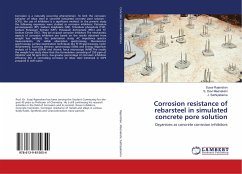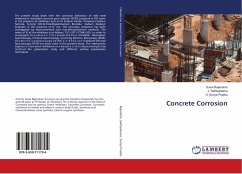Corrosion of reinforcement steel of concrete is one
of the main causes of deteriorations of structures.
Principally, it is an electrochemical process, which
can be divided by two mechanisms acidic and
chloride initiated corrosion. Optical sensoric
materials were prepared, which allow a
non-destructive monitoring of these processes. The
sensors are embedded into concrete structures and the
signal is transported through optical fibres.
pH indicator azo dyes have been synthesised for
monitoring of acidic attack. An aldehyde group has
been used as dye reactive functionality for the first
time. The dyes have been covalent bound to poly(vinyl
alcohol co ethylen) by acetal spacer bridge to assure
long term stability of the sensor. The colour change
of such prepared pH indicator materials occurs in the
pH interval of 11 to 13 and allows to predict the
acidic attack in an early stage. The response time of
these sensors is in the range of seconds. The optical
detection of chloride ions in alkaline media has been
investigated. Benzimidazolotrimethine dyes tend to
form J aggregates under influence of chloride ion
concentration in pH of 10 to 13. A suitable polymer
has been developed poly(vinyl alcohol co vinyl
butyral), in which the dye is dissolved as host guest
system. Such prepared sensor material allows a
precise determination of chloride concentration and
shows an excellent selectivity against other anions,
which are typical in the presence of concrete
structures. To the best of our knowledge it is the
first optical sensors for determination of chloride
in alkaline media.
of the main causes of deteriorations of structures.
Principally, it is an electrochemical process, which
can be divided by two mechanisms acidic and
chloride initiated corrosion. Optical sensoric
materials were prepared, which allow a
non-destructive monitoring of these processes. The
sensors are embedded into concrete structures and the
signal is transported through optical fibres.
pH indicator azo dyes have been synthesised for
monitoring of acidic attack. An aldehyde group has
been used as dye reactive functionality for the first
time. The dyes have been covalent bound to poly(vinyl
alcohol co ethylen) by acetal spacer bridge to assure
long term stability of the sensor. The colour change
of such prepared pH indicator materials occurs in the
pH interval of 11 to 13 and allows to predict the
acidic attack in an early stage. The response time of
these sensors is in the range of seconds. The optical
detection of chloride ions in alkaline media has been
investigated. Benzimidazolotrimethine dyes tend to
form J aggregates under influence of chloride ion
concentration in pH of 10 to 13. A suitable polymer
has been developed poly(vinyl alcohol co vinyl
butyral), in which the dye is dissolved as host guest
system. Such prepared sensor material allows a
precise determination of chloride concentration and
shows an excellent selectivity against other anions,
which are typical in the presence of concrete
structures. To the best of our knowledge it is the
first optical sensors for determination of chloride
in alkaline media.








